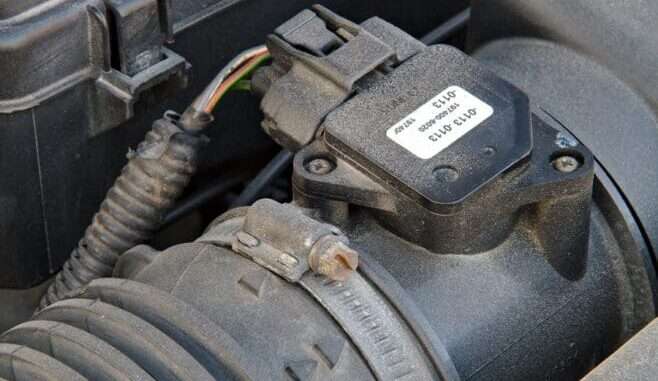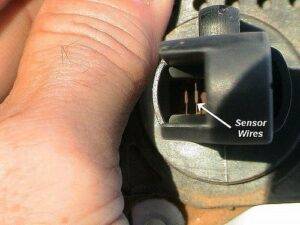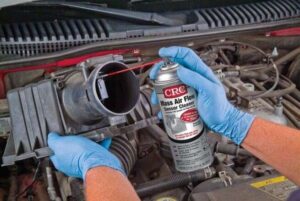
So, almost all newer vehicles on the road today, use a mass air flow sensor.
The mass air flow sensor, measures the volume and density, of the air entering the engine. In addition, it also measures, the temperature of the entering air.
Todays advanced electronic engine controls, estimate the right amount of fuel, to be used in any situation. To achieve that, they need the help from, additional sources. For example, fuel injectors, and camshaft position sensors.
Actually, the mass air flow sensor (MAF), is really part of your vehicles, fuel system.
So, the mass air flow sensor is always located, in the air stream, before the throttle body. However, there actually are a few different types, of (MAF) sensors.

I would say the most common one used today, is what is known as, the “hot-wire” (MAF) sensor.
So, when air passes across the (MAF), it cools the wire inside. As a result, increasing the amount of current needed to keep that wire, at the stated temperature. Hot wire sensors, typically have an operating range of, 0 – 5 volts. With idle voltage, being around, .5 – .8 volts. And, full throttle, being between, 4 and 5 volts.
So, the voltage required is proportional, to the amount of air flow. The computer uses this information, in conjunction with input from other sensors. Then, calculates the correct amount of fuel, to deliver to the engine.
Signs of a Faulty, Mass Air Flow (MAF) Sensor
So, a contaminated or failed (MAF), cannot measure the amount of air flow correctly. This causes the engine computer, to miscalculate the amount of fuel, to be injected. So, a failed mass air flow sensor, causes various driveability problems.
Don’t be fooled, as a faulty mass airflow sensor, can show symptoms, similar to low compression or low vacuum. And, can be similar to when your vehicle has, low fuel pressure.
Here are some of the most common failure signs, of a faulty mass air flow (MAF) sensor:
- The engine, is very hard to start.
- The engine stalls shortly after starting.
- Your engine consistently, runs lean or rich.
- The engine hesitates or drags, while under load or idle.
- Hesitation and jerking, during acceleration.
When your engine runs lean, a failure of the (MAF) sensor, can be a likely cause. Is your engine having trouble running or just idles bad? And, does the throttle, decrease at highway speed? Then, it is a possible sign of a defective (MAF) sensor. A faulty (MAF) sensor, can also turn on, the “Check Engine” light on your dashboard.
Engine Codes For (MAF) Sensor:

P0100 – Mass Air Flow Circuit Malfunction
A car with the code, P0100 may have some driveability issues, such as stalling, lack of power, surging, hesitation, etc. In some cars, the code P0100 can cause the, reduced engine power mode. Consequently, where the engine speed would be limited, to 2,500 – 3,000 rpm.
P0101 – Mass Air Flow Circuit Range/Performance
The engine computer, uses the mass air flow (MAF) sensor signal, to determine how much fuel to inject. If the sensor doesn’t measure the air flow correctly, the fuel injection system, won’t work properly.
Common symptoms include:
- Difficulty starting.
- The engine starts and stalls.
- Stalling.
- Unstable idle.
- Lack of power.
So, the mass air flow (MAF) sensor reading, is used to calculate the engine load. Therefore, the traction control system may stop working and cause, the warning light to come on. For the same reason, the automatic transmission shifting pattern, may also change.
Trouble codes, P0171 System Too Lean (Bank 1) and P0174 System Too Lean (Bank 2). Can also be caused by, a bad or contaminated (MAF) sensor.
Before you replace your mass air flow (MAF) sensor, there might be a chance, a cleaning is all you need.
Mass Air Flow Sensor Cleaner
Sometimes you can get away with, just cleaning the sensing wire, with (MAF) sensor cleaning spray. Avoid touching the wire.

Above all, never clean the wire with a rag or cleaners, not intended for a (MAF) sensor or electrical contacts. Most people like to clean it on the vehicle, but I always remove it first.
It is a easy job and that way, it allows for a better inspection. Always, inspect the connector for dirt and corrosion, as that could also be the problem.
Stay tuned for another post on, testing and troubleshooting your, Mass Air Flow (MAF) Sensor.
Conclusion
Usually when the sensor is failing, it will let the engine run rich, using more fuel. It will also, cause the engine to be sluggish on acceleration. As a result, a engine running this way, will eventually develop some other problems.
The raw fuel that makes it out of the engine and into exhaust, will eventually cause the oxygen (O2) sensor to fail. Given enough time, the fuel and soot, will also ruin, the catalytic converter.
Basically, the problem will keep getting worse. And, not fixing it right away, will wind up costing you more money in the long run. Catalytic converters, in particular, are a fairly expensive part. So, if you see any of the above symptoms, get it check as soon as possible.
Thank You !



